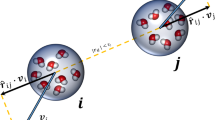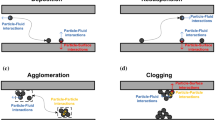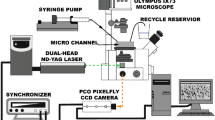Abstract
We simulate a microfluidic conveying system using the many-body dissipative particle dynamics method (MDPD). The conveying system can transport micro parts to a specified spot on a surface by letting them float inside or on top of a droplet, which is pumped by changing the wetting behaviour of the substrate, e.g., with electrowetting on dielectrics. Subsequent evaporation removes the fluid; the micro part remains on its final position, where a second substrate can pick it up. In this way, the wetting control can be separate from the final device substrate. The MDPD method represents a fluid by particles, which are interpreted as a coarse graining of the fluid’s molecules. The choice of interaction forces allows for free surfaces. To introduce a contact angle model, non-moving particles beyond the substrate interact with the fluid particles by MDPD forces such that the required contact angle emerges. The micro part is simulated by particles with spring-type interaction forces.





Similar content being viewed by others
References
Allen MP, Tildesley DJ (1987) Computer simulation of liquid. Clarendon, Oxford
Berge B (1993) Electrocapillarity and wetting of insulator films by water. C R Acad Sci Ser II Mech Phys Chim Sci Terre Univ 317:157–163
Buff FP (1956) Curved fluid interfaces. I. the generalized Gibbs–Kelvin equation. J Chem Phys 25(1):146–153
Bykhovskii AI (1974) Effects of external influences on the spreading of a liquid phase on a crystal surface—a review. Poroshkovaya Metallurgiya 133(1):50–62 (Translated from Poroshkovaya Metallurgiya)
Chiou PY, Moon H, Toshiyoshi H, Kim C-J, Wu MC (2003) Light actuation of liquid by optoelectrowetting. Sens Actuators A Phys A104(3):222–228
Cho SK, Moon H, Fowler J, Kim C-J (2001) Splitting a liquid droplet for electrowetting-based microfluidics. In: Proceedings of the ASME IMECE, Number IMECE2001/MEMS-23831, NY
Cho SK, Moon H, Kim C-J (2003) Creating, transporting, cutting, and merging liquid droplets by electrowetting-based actuation for digital microfluidic circuits. J Microelectromech Syst 12(1):70–80
Decamps C, Coninck JD (2000) Dynamics of spontaneous spreading under electrowetting conditions. Langmuir 16(26):10150–10153
Dimitrakopoulos P, Higdon JJL (1997) Displacement of fluid droplets from solid surfaces in low-Reynolds-number shear flows. J Fluid Mech 336:351–378
Español P (1995) Hydrodynamics from dissipative particle dynamics. Phys Rev E 52(2):1734–1742
Feenstra BJ, Hayes RA, van Dijk R, Boom RGH, Wagemans MMH, Camps IGJ, Giraldo A, Heijden Bvd (2006) Electrowetting-based displays: bringing microfluidics alive on-screen. In: Proceedings of the IEEE MEMS Istanbul, Turkey, pp 48–53
Groot RD, Rabone KL (2001) Mesoscopic simulation of cell membrane damage, morphology change and rupture by nonionic surfactants. Biophys J 81(2):725–736
Gurrum SP, Murthy S, Joshi YK (2002) Numerical simulation of thermocapillary pumping using level set method. In: Proceedings of the 5th ISHMT/ASME HMTC, Kolkota, India
Hirt CW, Nichols BD (1981) Volume of fluid (VOF) method for the dynamics of free boundaries. J Comput Phys 39:201–225
Hoogerbrugge PJ, Koelman JMVA (1992) Simulating microscopic hydrodynamic phenomena with dissipative particle dynamics. Europhys Lett 19(3):155–160
Ivošević N, Žutić V (1998) Spreading and detachment of organic droplets at an electrified interface. Langmuir 14(7):231–234
Janocha B, Bauser H, Oehr C, Brunner H, Göpel W (2000) Competitive electrowetting of polymer surfaces by water and decane. Langmuir 16(7):3349–3354
Karlsson R, Karlsson M, Karlsson A, Cans A-S, Bergenholtz J, Åkerman B, Ewing AG, Voinova M, Orwar O (2002) Moving-wall-driven flows in nanofluidic systems. Langmuir 18(11):4186–4190
Kauzlaric D, Greiner A, Korvink J, Schulz M, Heldele R (2005) M of advanced micro and nanosystems, chapter modeling micro PIM, Wiley-VCH, Weinheim, pp 51–84. http://dx.doi.org/10.1002/9783527616725
Kim C-J (2001) Micropumping by electrowetting. In: Proceedings of the ASME IMECE, Number IMECE2001/HTD-24200, NY
Kreisselmeier G, Steinhauser R (1979) Systematic control design by optimizing a vector performance index. In: Proceedings of the IFAC Symposium on computer aided design of control systems, Zürich, pp 113–117
Lazarou P, Aspragathos N, Jung E (2006) Micropart manipulation by electrical fields for highly parallel batch assembly. In: Proceedings of the 4M Conference 2006, Grenoble, France
Lee J, Kim C-J (1999) Theory and modeling of continuous electrowetting microactuation. In: Proceedings of the MEMS (MEMS-vol 1), ASME IMECE, vol 1, Nashville, TN, pp 397–403
Lee J, Kim C-J (2000) Surface tension driven microactuation based on continuous electrowetting (CEW). J Microelectromech Syst 9(2):171–180
Lee J, Moon H, Fowler J, Schoellhammer T, Kim C-J (2002) Electrowetting and electrowetting-on-dielectric for microscale liquid handling. Sensor Actuat A Phys 95(2–3):259–268
Lienemann J, Greiner A, Korvink JG (2006) Modeling, simulation and optimization of electrowetting. IEEE T Comput Aid D (Special Issue on Design Automation Methods and Tools for Microfluidics-Based Biochips) 25(2):234–247
Lienemann J, Greiner A, Korvink JG, Xiong X, Hanein Y, Böhringer KF (2004) Modelling, simulation and experimentation of a promising new packaging technology—parallel fluidic self-assembly of micro devices. Sens Update 13:3–43
Monaghan JJ (1988) An introduction to sph. Comput Phys Commun 48(1):89–96
Moon I, Kim J (2006) Using EWOD (electrowetting-on-dielectric) actuation in a micro conveyor system. Sens Actuators A Phys 130–131:537–544
Moriarty JA, Schwartz LW, Tuck EO (1991) Unsteady spreading of thin liquid films with small surface tension. Phys Fluids A Fluid 3(5):733–742
Nakamura Y, Kamada K, Katoh Y, Watanabe A (1973) Studies on secondary electrocapillary effects: I. The confirmation of the Young–Dupré equation. J Colloid Interf Sci 44(3):517–524
Nakamura Y, Matsumoto M, Nishizawa K, Kamada K, Watanabe A (1977) Studies on secondary electrocapillary effects: II. The electrocapillary phenomena in thin liquid film. J Colloid Interf Sci 59(2):201–210
Noguchi H, Gompper G (2007) Transport coefficients of dissipative particle dynamics with finite time step. Europhys Lett 79(3):36002. doi:10.1209/0295-5075/79/36002
Pagonabarraga I, Frenkel D (2001) Dissipative particle dynamics for interacting systems. J Chem Phys 115(11):5015–5026
Peters EAJF (2004) Elimination of time step effects in DPD. Europhys Lett 66(3):311–317
Rübenkönig O (2008) Free surface flow and the IMTEK mathematica supplement. PhD thesis, University of Freiburg, Germany
Sammarco TS, Burns MA (1999) Thermocapillary pumping of discrete drops in microfabricated analysis devices. AIChE J 45(2):350–366
Sammarco TS, Burns MA (2000) Heat-transfer analysis of microfabricated thermocapillary pumping and reaction devices. J Micromech Microeng 10(1):42–55
Schneemilch M, Welters WJJ, Hayes RA, Ralston J (2000) Electrically induced changes in dynamic wettability. Langmuir 16(6):2924–2927
Trofimov SY, Nies ELF, Michels MAJ (2002) Thermodynamic consistency in dissipative particle dynamics simulations of strongly nonideal liquids and liquid mixtures. J Chem Phys 117(20):9383–9394
Trozzi C, Ciccotti G (1984) Stationary nonequilibrium states by molecular dynamics. II. Newton’s law. Phys Rev A 29(2):916–925
Vallet M, Vallade M, Berge B (1999) Limiting phenomena for the spreading of water on polymer films by electrowetting. Eur Phys J B 11(4):583–591
Verheijen HJJ, Prins MWJ (1999) Reversible electrowetting and trapping of charge: model and experiments. Langmuir 15(20):6616–6620
Warren PB (2003) Vapor-liquid coexistence in many-body dissipative particle dynamics. Phys Rev E 68(6):066702
Zeng J (2004) Electrohydrodynamic modeling and simulation and its application to digital microfluidics. In: Lab-on-a-Chip. Proceedings of the SPIE, vol 5591, pp 125–142
Acknowledgments
The authors acknowledge complete funding by the DFG via the project Electrowetting-Simulation mit Partikelmethoden (Grant No. LI 1831/1-2).
Author information
Authors and Affiliations
Corresponding author
Rights and permissions
About this article
Cite this article
Lienemann, J., Weiß, D., Greiner, A. et al. Insight into the micro scale dynamics of a micro fluidic wetting-based conveying system by particle based simulation. Microsyst Technol 18, 523–530 (2012). https://doi.org/10.1007/s00542-012-1460-x
Received:
Accepted:
Published:
Issue Date:
DOI: https://doi.org/10.1007/s00542-012-1460-x




